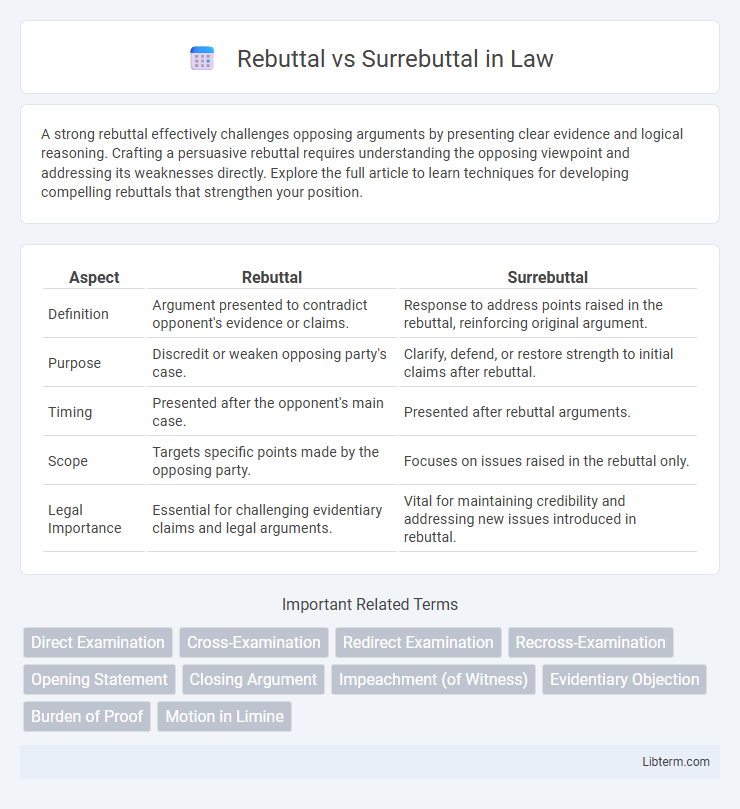A strong rebuttal effectively challenges opposing arguments by presenting clear evidence and logical reasoning. Crafting a persuasive rebuttal requires understanding the opposing viewpoint and addressing its weaknesses directly. Explore the full article to learn techniques for developing compelling rebuttals that strengthen your position.
Table of Comparison
| Aspect | Rebuttal | Surrebuttal |
|---|---|---|
| Definition | Argument presented to contradict opponent's evidence or claims. | Response to address points raised in the rebuttal, reinforcing original argument. |
| Purpose | Discredit or weaken opposing party's case. | Clarify, defend, or restore strength to initial claims after rebuttal. |
| Timing | Presented after the opponent's main case. | Presented after rebuttal arguments. |
| Scope | Targets specific points made by the opposing party. | Focuses on issues raised in the rebuttal only. |
| Legal Importance | Essential for challenging evidentiary claims and legal arguments. | Vital for maintaining credibility and addressing new issues introduced in rebuttal. |
Introduction to Rebuttal and Surrebuttal
Rebuttal and surrebuttal are critical components of legal and debate discourse, used to counter opposing arguments. A rebuttal introduces evidence or reasoning that directly challenges the claims made by the opposing party, aiming to weaken their position. Surrebuttal follows as a response to the rebuttal, providing further clarification or new evidence to defend the original argument or address points raised in the rebuttal.
Definitions: Rebuttal vs. Surrebuttal
A rebuttal is a formal response that challenges or contradicts the claims made by an opponent, aiming to disprove or weaken their argument. A surrebuttal follows the rebuttal and serves as a counter-response to address and refute the points raised during the rebuttal phase. Both rebuttal and surrebuttal are critical stages in legal cases, debates, and structured arguments that ensure thorough examination of opposing viewpoints.
Purpose and Function in Legal Proceedings
Rebuttal aims to challenge and refute evidence or testimony presented by the opposing party, strengthening a party's case by directly addressing weaknesses. Surrebuttal allows the responding party to counter the opposing side's rebuttal, ensuring a balanced opportunity to clarify or dispute new points raised. Both serve as critical stages in legal proceedings to maintain fairness and thorough examination of the facts.
Key Differences Between Rebuttal and Surrebuttal
Rebuttal directly addresses and refutes arguments presented by the opposing party, aiming to weaken their position. Surrebuttal serves as a further response to the rebuttal, allowing the original party to defend or clarify their initial claims after the rebuttal is presented. The key difference lies in their sequence and purpose: rebuttal initiates the counterargument phase, while surrebuttal provides the final opportunity to respond before the conclusion of the debate.
When Is a Rebuttal Used?
A rebuttal is used during a debate or legal proceeding to directly challenge or contradict the opposing party's argument, presenting evidence or reasoning to weaken their claims. It typically occurs immediately after the opposing argument is made, aiming to address specific points raised and demonstrate flaws or inaccuracies. Rebuttals are essential for clarifying misunderstandings and reinforcing the rebutting party's position before the opponent is given the chance to deliver a surrebuttal.
When Is a Surrebuttal Necessary?
A surrebuttal becomes necessary when new evidence or arguments emerge during the rebuttal phase that were not previously addressed, allowing the original party to respond and clarify their position. This reply helps maintain the balance of information, ensuring that both sides of the dispute are fairly represented before a decision is made. Courts and legal procedures often set strict guidelines for surrebuttals to prevent undue extensions of the trial process.
Procedural Rules Governing Rebuttal and Surrebuttal
Procedural rules governing rebuttal and surrebuttal dictate the order and scope of presenting evidence and arguments in legal proceedings, ensuring fairness and clarity. Rebuttal allows a party to counter evidence introduced by the opposing party during the initial presentation, while surrebuttal provides a limited opportunity to respond specifically to new points raised during rebuttal. Courts often impose strict time limits and restrict surrebuttal to matters directly related to the rebuttal phase, preventing undue prolongation of the trial.
Strategic Use of Rebuttal and Surrebuttal in Court
Strategic use of rebuttal and surrebuttal in court involves presenting precise evidence or arguments that directly counter opposing claims, strengthening a party's position. Rebuttals serve to challenge the opposing party's case immediately after their presentation, while surrebuttals respond specifically to rebuttal points, ensuring comprehensive defense. Effective timing and clarity in these responses can influence the judge or jury's perception, ultimately impacting the trial's outcome.
Common Misconceptions
Rebuttal is often mistaken as the final response in a debate, but it primarily serves to challenge opposing arguments with evidence and reasoning. Surrebuttal, frequently misunderstood, is actually a critical follow-up allowing a party to address new points raised during the rebuttal phase. Confusing these phases can lead to ineffective argument strategies and weaken a team's overall performance in competitive debating or legal proceedings.
Conclusion: Importance in the Litigation Process
Rebuttal and surrebuttal play crucial roles in the litigation process by allowing parties to address and counter opposing evidence and arguments effectively. The rebuttal phase enables the plaintiff or defense to challenge the opponent's claims after initial presentations, while the surrebuttal offers a final opportunity to respond to those challenges, ensuring fairness and thoroughness. These stages enhance the judge or jury's understanding of disputed issues, contributing to a well-informed and balanced decision.
Rebuttal Infographic

 libterm.com
libterm.com